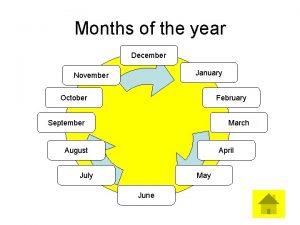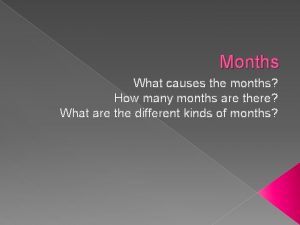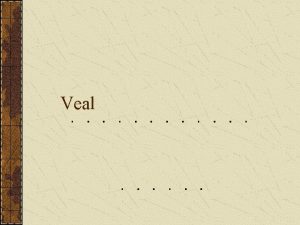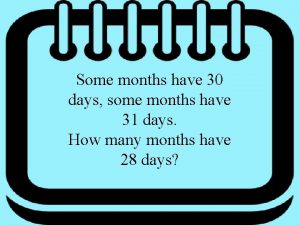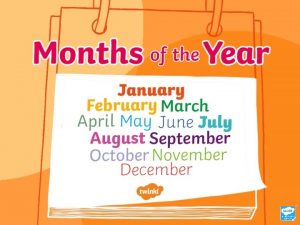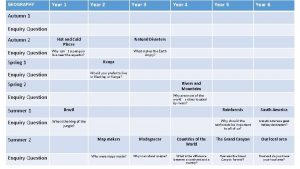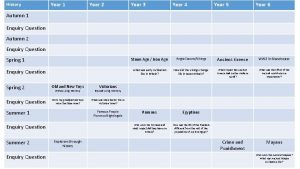The Months of the year The 12 Months

















- Slides: 17

The Months of the year.

The 12 Months The Gregorian calendar consists of the following 12 months: January — 31 days February — 28 days in a common year and 29 days in leap years March — 31 days April — 30 days May — 31 days June — 30 days July — 31 days August — 31 days September — 30 days October — 31 days November — 30 days December — 31 days.

How Many Have 28, 29, 30, or 31 Days? The Gregorian calendar has 4 months that are 30 days long and 7 months that are 31 days long. February is the only month that is 28 days long in common years and 29 days long in leap years.

January is the first month of the year in the Julian and Gregorian calendars and the first month to have the length of 31 days. The first day of the month is known as New Year's Day. It is, on average, the coldest month of the year within most of the Northern Hemisphere (where it is the second month of winter) and the warmest month of the year within most of the Southern Hemisphere (where it is the second month of summer). In the Southern hemisphere, January is the seasonal equivalent of July in the Northern hemisphere and vice versa.

February is the second month of the year in the Julian and Gregorian calendars. It is the shortest month of the year as it is the only month to have a length of less than 30 days. The month has 28 days in common years or 29 days in leap years, with the quadrennial 29 th day being called the "leap day. “ February is the third month of meteorological winter in the Northern Hemisphere. In the Southern Hemisphere, February is the last month of summer (the seasonal equivalent of August in the Northern

March is the third month of the year in both the Julian and Gregorian calendars. It is the second month to have a length of 31 days. In the Northern Hemisphere, the meteorological beginning of spring occurs on the first day of March. The March equinox on the 20 th or 21 st marks the astronomical beginning of spring in the Northern Hemisphere and the beginning of autumn in the Southern Hemisphere, where September is the seasonal equivalent of the Northern Hemisphere's March.

April is the fourth month of the year in the Gregorian calendar, the fifth in the early Julian and the first month to have the length of 30 days. April is commonly associated with the season of spring in parts of the Northern Hemisphere and autumn in parts of the Southern Hemisphere, where it is the seasonal equivalent to October in the Northern Hemisphere and vice versa.

May is the fifth month of the year in the Julian and Gregorian Calendars and the third month to have the length of 31 days. May is a month of spring in the Northern Hemisphere and autumn in the Southern Hemisphere. Therefore, May in the Southern Hemisphere is the seasonal equivalent of November in the Northern Hemisphere and vice versa. Late May typically marks the start of the summer vacation season in the United States and Canada and ends on Labor Day, first Monday of September.

Jane June is the sixth month of the year in the Julian and Gregorian calendars and the second month to have the length of 30 days. June contains the summer solstice in the Northern Hemisphere, the day with the most daylight hours, and the winter solstice in the Southern Hemisphere, the day with the fewest daylight hours (excluding polar regions in both cases). June in the Northern Hemisphere is the seasonal equivalent to December in the Southern Hemisphere and vice versa. In the Northern hemisphere, the beginning of the traditional astronomical summer is 21 June (meteorological summer begins on 1 June). In the

July is the seventh month of the year (between June and August) in the Julian and Gregorian Calendars and the fourth month to have the length of 31 days. It was named by the Roman Senate in honour of Roman general Julius Cæsar, it being the month of his birth. Prior to that, it was called Quintilis.

August is the eighth month of the year in the Julian and Gregorian calendars, falling between July and September, and the fifth month to have the length of 31 days. It was originally named Sextilis in Latin because it was the sixth month in the original ten-month Roman calendar under Romulus in 753 BC, and March was the first month of the year. About 700 BC, it became the eighth month when January and February were added to the year before March by King Numa Pompilius, who also gave it 29 days. Julius Caesar added two days when he created the Julian calendar in 45 BC, giving it its modern length of 31 days. In 8 BC, it was renamed in honor of Augustus. According to a Senatus consultum quoted by Macrobius, he chose this month because it was the time of several of his great triumphs, including the conquest of Egypt.

September is the ninth month of the year in the Julian and Gregorian calendars and the third month to have the length of 30 days. September in the Northern Hemisphere is the seasonal equivalent of March in the Southern Hemisphere. In the Northern hemisphere, the beginning of the meteorological autumn is on 1 September. In the Southern hemisphere, the beginning of the meteorological spring is on 1 September.

October is the tenth month of the year in the Julian and Gregorian Calendars and the sixth month to have the length of 31 days. The eighth month in the old Roman calendar, October retained its name (from the Latin ôctō meaning "eight") after January and February were inserted into the calendar that had originally been created by the Romans. In Ancient Rome, one of three Mundus patet would take place on October 5, Meditrinalia October 11, Augustalia on October 12, October Horse on October 15, and Armilustrium on October 19. These dates do not correspond to the modern Gregorian calendar. Among the Anglo-Saxons, it was known as Winterfylleth, because at this full moon (fylleth) winter was supposed to begin

November is the eleventh and penultimate month of the year in the Julian and Gregorian Calendars and the fourth and last month to have the length of 30 days. November was the ninth month of the ancient Roman calendar. November retained its name (from the Latin novemmeaning "nine") when January and February were added to the Roman calendar. November is a month of late spring in the Southern Hemisphere and late autumn in the Northern Hemisphere. Therefore, November in the Southern Hemisphere is the seasonal equivalent of May in the Northern Hemisphere and vice versa. In Ancient Rome, Ludi Plebeii was held from November 4– 17, Epulum Jovis was held on November 13, and Brumalia celebrations began on November 24. These dates do not correspond to the modern Gregorian calendar. November was referred to as Blōtmōnaþ by the Anglo. Saxons. Brumaire and Frimaire were the months on which November fell in the French Republican Calendar.

December is the twelfth and final month of the year in the Julian and Gregorian Calendars. It is the seventh and last month to have the length of 31 days. December, from the Très Riches Heures du duc de Berry December got its name from the Latin word decem (meaning ten) because it was originally the tenth month of the year in the Roman calendar, which began in March. The winter days following December were not included as part of any month. Later, the months of January and February were created out of the monthless period and added to the beginning of the calendar, but December retained its name.


Milena Manucharyan 8 -4
 Abbreviations of the months
Abbreviations of the months Twelve months in a year
Twelve months in a year Months of the year december
Months of the year december Months of the year lesson
Months of the year lesson Days of the week and months of the year
Days of the week and months of the year Agnpc
Agnpc Nov 22
Nov 22 Year 6 leavers poem ideas
Year 6 leavers poem ideas Sơ đồ cơ thể người
Sơ đồ cơ thể người ưu thế lai là gì
ưu thế lai là gì Tư thế ngồi viết
Tư thế ngồi viết Cái miệng nó xinh thế
Cái miệng nó xinh thế Hình ảnh bộ gõ cơ thể búng tay
Hình ảnh bộ gõ cơ thể búng tay đặc điểm cơ thể của người tối cổ
đặc điểm cơ thể của người tối cổ Cách giải mật thư tọa độ
Cách giải mật thư tọa độ Tư thế ngồi viết
Tư thế ngồi viết Chó sói
Chó sói Thẻ vin
Thẻ vin


